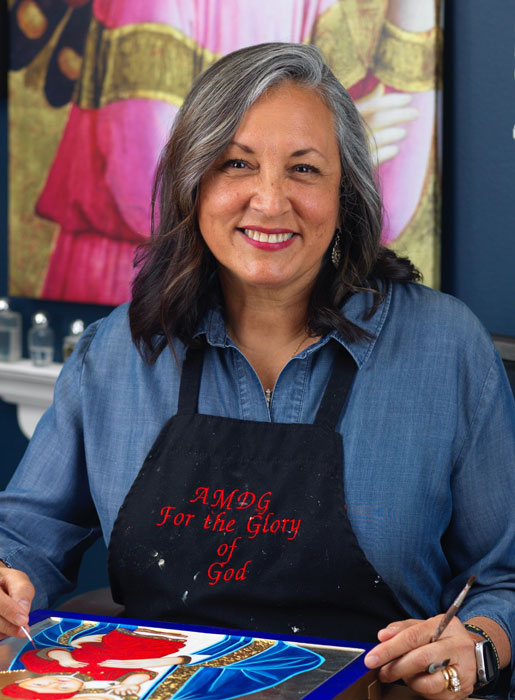The Art of the Divine
With symbols, paint and prayer, iconographer Vivian Imbruglia opens windows to heaven through her art.
Published: September 17, 2021 / Author: Carol Elliott
Vivian Imbruglia is precise in how she describes her work.
She’s an iconographer, not an artist. She writes icons; she doesn’t paint them.
These distinctions are not persnicketies on Imbruglia’s part, but a deep-seated desire for those who encounter an icon to understand that they are not looking at a mere painting, but no less than a window into heaven.

Vivian Imbruglia
“An icon explained simply is not considered art, it is considered a prayer,” said Imbruglia in a recent interview from her home in Rancho Cucamonga, California. “Once blessed, it is actually a window into heaven, and I can explain that. When you see an icon of ‘Our Lady of Sorrows,’ you are actually looking at an image of her, and she is looking at you. There’s a beautiful, mystical thing about icons. They are meant to draw people in. It becomes a living piece.”
“Our Lady of Sorrows” is an icon Imbruglia created to commemorate the special occasion of the Mendoza College of Business’ 100th anniversary. The name is a reference to Mary, the mother of Jesus Christ, where the sorrows refer to the “Seven Sorrows of Mary” — seven events during the life of Christ when Mary willingly suffered alongside her Divine Son as He gave His life to save the world. The icon will be blessed by University president Rev. John I. Jenkins, C.S.C., as part of a Centennial Mass on Sept. 30 at the Basilica of the Sacred Heart. The icon will be permanently installed in the St. Matthew Chapel in the Stayer Center.
An icon is said to be “written” rather than painted because its purpose is to convey the Word of God. (It comes from the Greek words “eikon” meaning “image” and “graphe” meaning “writing.”) Iconography, especially religious iconography, involves the complex use of culturally specific symbols, motifs and colors to convey meaning that goes beyond visually storytelling. Early Christian iconography became a way for a largely illiterate public to “read” God’s word. Through the centuries, the use of a consistent set of signs and symbols conveys the same meanings understood by Christians regardless of the style of artwork.
Imbruglia has created more than 200 icons, which are installed in locations ranging from private homes to the Vatican. Her foray into iconography was unintentional, at least by her. She took a night off from her busy schedule to take her mom to a Tuesday night art class with every intention of just observing.
“The teacher said, ‘You can join the class if you want.’ And literally, I describe this day, I was sitting at a table all by myself and everybody else was sitting on a long table, yacking away, all these women. And it was this quiet moment where I felt like the ceiling opened up. I felt like it was like this awakening of, ‘This is what you’re going to do.’ It was so beautiful. I said, ‘Can I join this class?’ And I never called it an art class after that, it was an icon class.”
Eventually, Imbruglia outgrew the teacher and began studying under master iconographers. She worked during the day at a school, but then would come home after work, clear the kitchen table and begin painting icons. The day came when she realized that being an iconographer was her full-time calling.
Imbruglia views her mission as helping others on their faith walks by giving them sacred images to meditate on in order to deepen their understanding. Each image begins with research, reading biographies and studying devotions. Prayer is a necessary part of every work, as each session begins with prayer, and prayerful music is often played in the background while she works.
“There’s not a lot of TV that goes on. It is amazing what you learn to cut out,” she said. “Instead, I fill that time with Gregorian chants. I always burn incense. I want to bring the smells of my church in and offer prayer while I’m working.” She also might play a video about, for example, Mother Teresa’s life, or listen to a priest describe the meaning of a saint’s life. “So, it’s surrounding yourself with that person,” she said. “There’s a lot of emotional prep, I guess you could say, that goes into it.”
She noted the amount of symbolism in each piece. “You just don’t sit down and decide, ‘I’m going to paint a picture of the Blessed Virgin Mary,’” she said. “I had a student once say, ‘I want to paint the Blessed Mother and I want her gown to match my wallpaper.’ And I was like, ‘Uh, no, no,’ and then I had to explain again. Certain colors are used because they represent certain things.”
Usually Mary is painted in blues, reds and whites, she explained. White for purity, blue for royalty, red for mercy and royalty again. “I wouldn’t put her in orange or yellow, unless she was glowing and yellow,” she added. “So, there are rules to be followed in iconography.”
“Our Lady of Sorrows” (by Vivian Imbruglia; located in Stayer Center chapel)
For Imbruglia, the most important part of the icon are the actual eyes of the person, the saint or whoever is represented in the icon. “It’s like I almost stop and pray during that time that those eyes will draw the person that needs to be drawn in,” she said. “You could walk by one and go, ‘Oh yeah, that’s pretty,’ but the next person might walk by and maybe kneel down and feel so drawn into it. And that is why I pray so hard during those eyes, that they actually draw that person in to know that devotion even more. It’s very, very personal, very personal.”
Her icons tend to feature more natural looking faces, where in some icons they’re very stark, said Imbruglia. “But I do still follow, for instance, the style you’ll see on a lot of the icons, where the nose is very long and looks almost odd. But that represents nobility. Or you’ll see really big ears in icons and people will think that looks strange, but it’s because they’re hearing the Word of God.” Likewise, she explained, eyes are sometimes extraordinarily big because they’ve seen the beatific vision.
“So, it’s all symbolic. It’s unlike art where you paint a horse and you paint it brown and put whatever you want on it,” she said. “There are rules that need to be followed in a piece like this, starting from the piece of wood that you use and the way the grains go.”
“Our Lady of Sorrows” icon recalls the Seven Sorrows of Mary devotion, which became standard in the Church around the 14th century. The devotion is meant as a reminder that in Mary’s suffering, the faithful can find a way to understand their own suffering. By meditating on her sorrows, they gain understanding that God is present and active even during times of pain and loss. The founder of the Congregation of Holy Cross, Blessed Basil Moreau, selected Our Lady of Sorrows as the patron of the congregation.
The St. Matthew Chapel icon is painted on a base of birch wood to represent a church altar or the cross of Christ, with the wood grain going upward to represent the Tree of Life. Throughout the 30-inch by 40-inch piece, 24-karat gold embossing — including the hand-crafted roses and embellishments — symbolize the radiance of heaven.
Across the arched top, the icon features three circles depicting the Holy Trinity: the hand of the Father in the traditional sign of blessing, the Lamb signifying Christ and the dove representing the Holy Spirit. In the main panel, Mary’s halo includes seven stars to represent the seven sorrows. Her blue mantle and gold trim is embossed with a pattern of thorns to recall the sorrow and agony of the crown of thorns worn by Christ. At her feet are red and white roses representing the Hail Marys and Our Fathers prayed as part of the Seven Sorrows devotion.
The insets depict the Seven Sorrows of Mary:
- The Prophecy of Simeon (Luke 2:34-35)
- The Flight into Egypt (Matthew 2:13-21)
- The Loss of Jesus for Three Days (Luke 2:41-50)
- The Carrying of the Cross (John 19:17)
- The Crucifixion of Jesus (John 19:18-30)
- Jesus Taken Down from the Cross (John 19:39-40)
- Jesus Laid in the Tomb (John 19:39-42)
“I think one of the most beautiful parts of this journey began at the beginning of Lent and it took me about six weeks to complete this icon,” said Imbruglia. “And so, it was like a gift for me. I was able to contemplate during Lent all of these sorrows leading up to Easter. This was my Lenten journey.”
And somewhere in the icon, carefully hidden among the gilded roses adorning the ornate frame, you will find the tiny letters: A-M-D-G.
Ad Majorem Dei Gloriam.
“Years ago, the expression gave purpose to what I was doing,” she said. She was working on portraying the Stations of the Cross for her church when a little old man walked in and asked what she was doing.
“I said, ‘Oh, I’m painting the Stations of the Cross.’” She recalled. “And he said, ‘No, what are you doing?’ He asked me three times and I was like, ‘Well, the church wanted me to do this.’ He said, ‘No. Why are you doing this?’ And I answered, ‘For Him.’
“And he said, ‘Ad Majorem Dei Gloriam. For the greater glory of God. That’s why you’re doing it.’
“And I said, ‘Yes.’”



